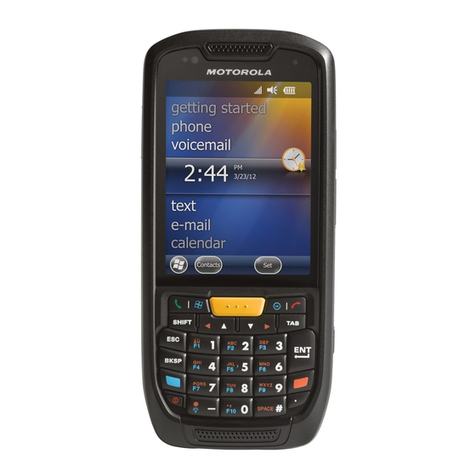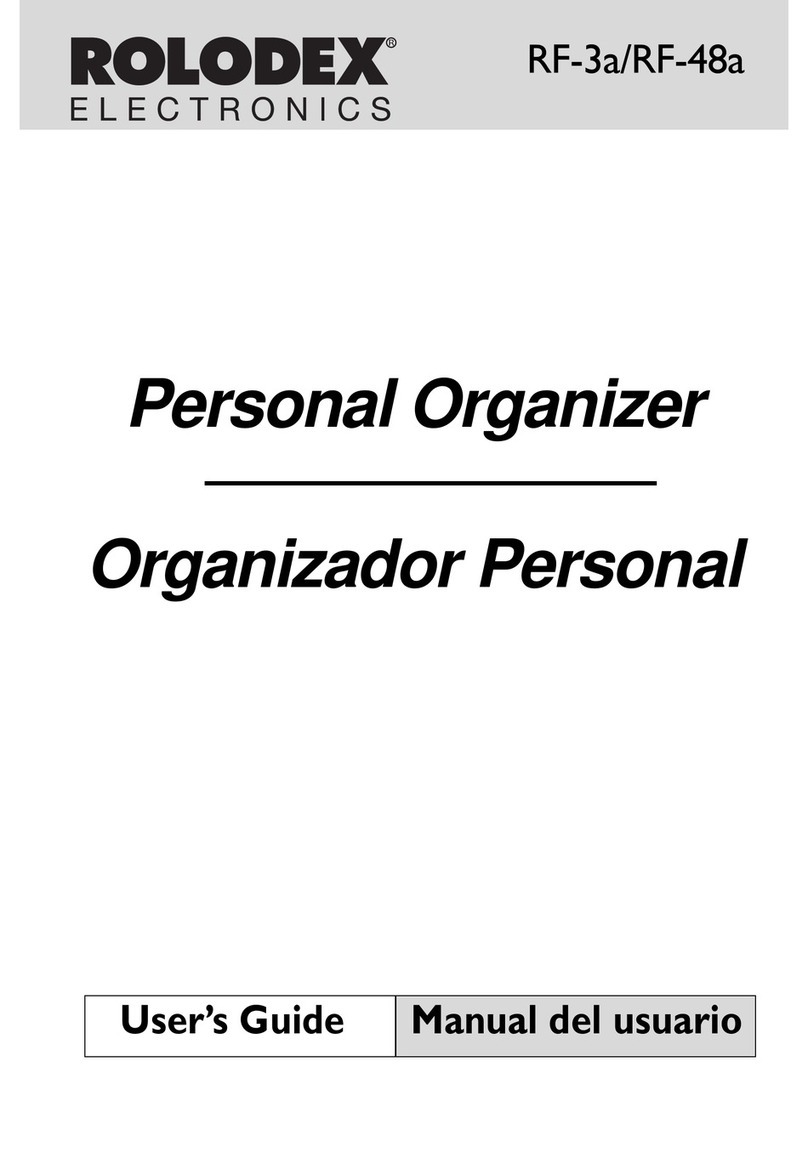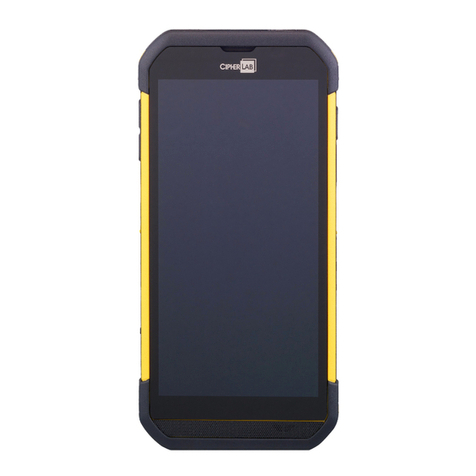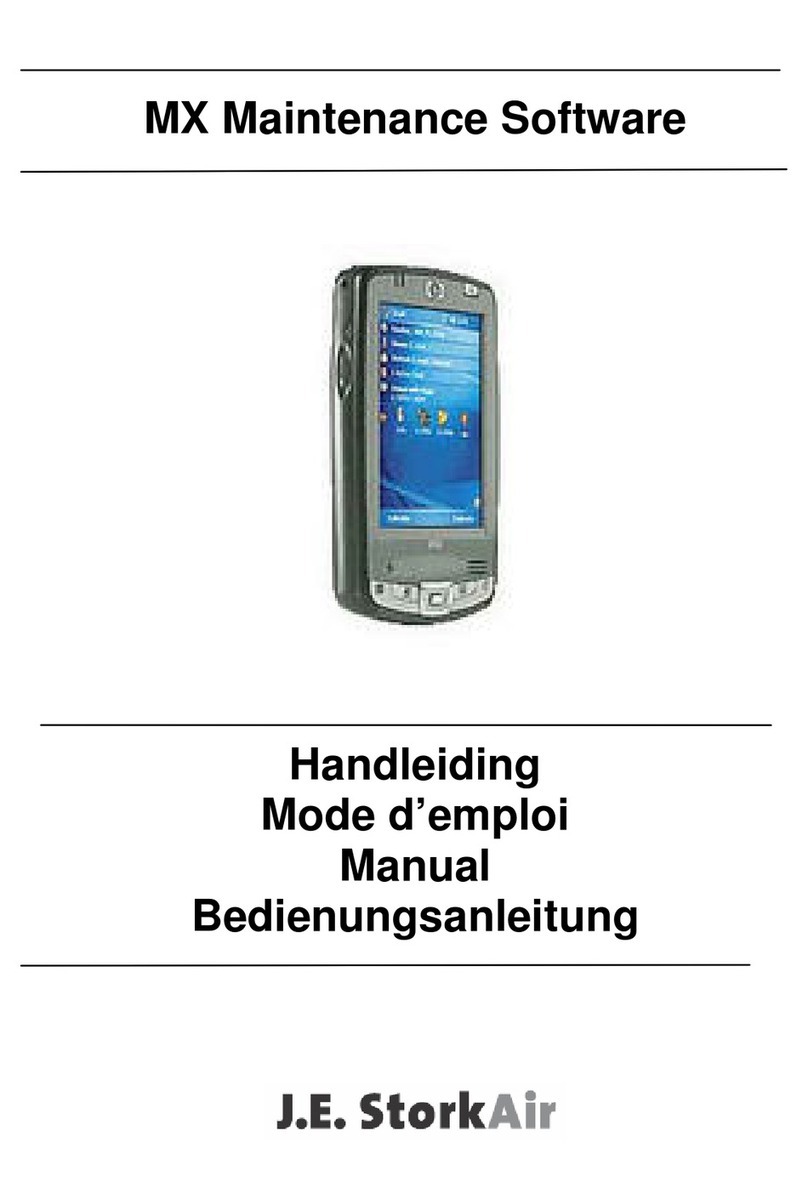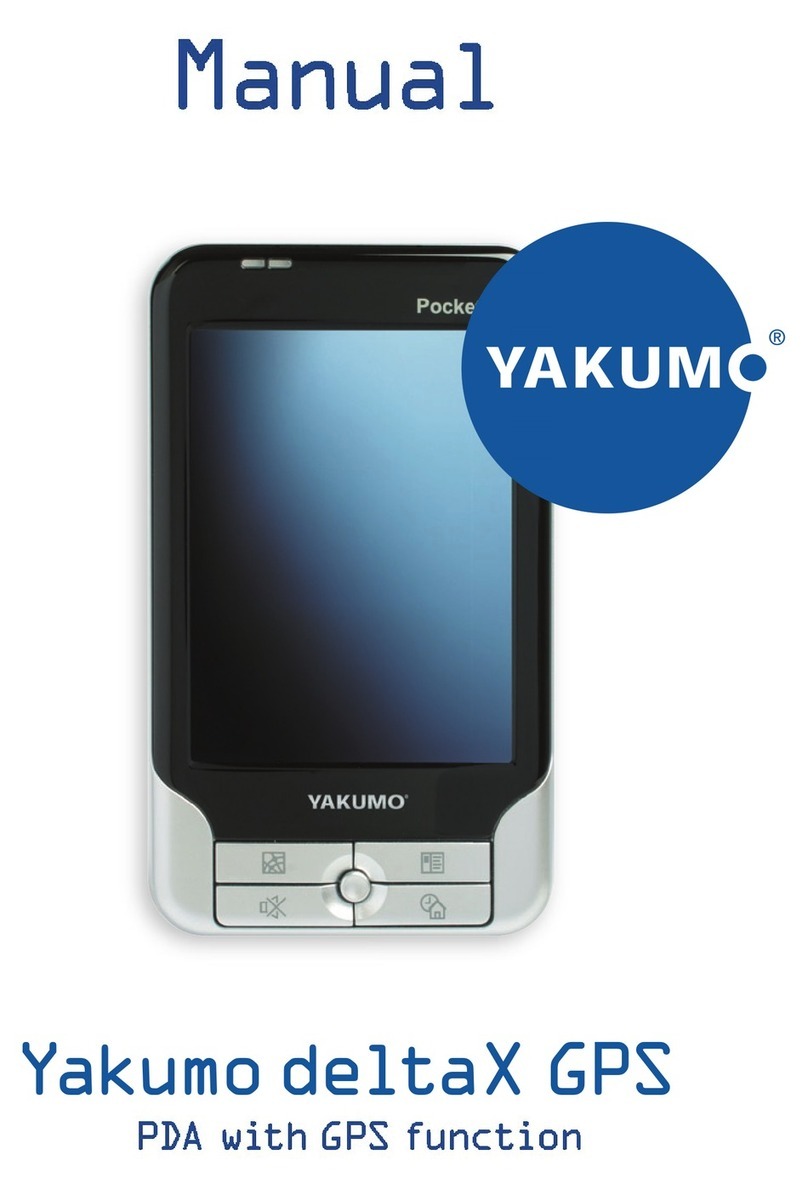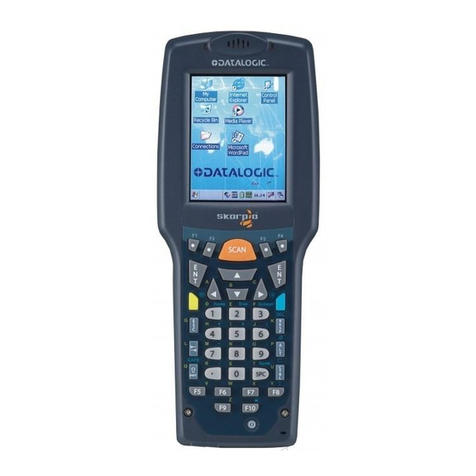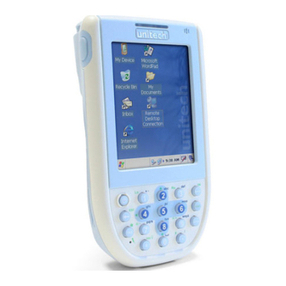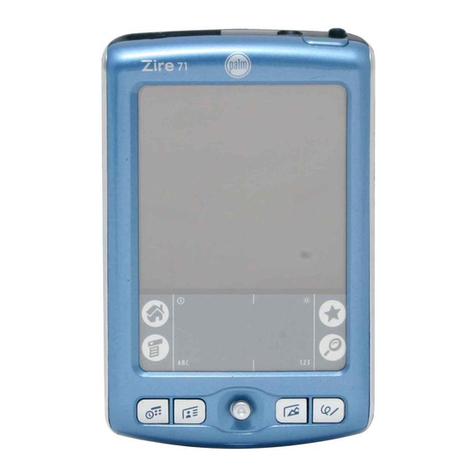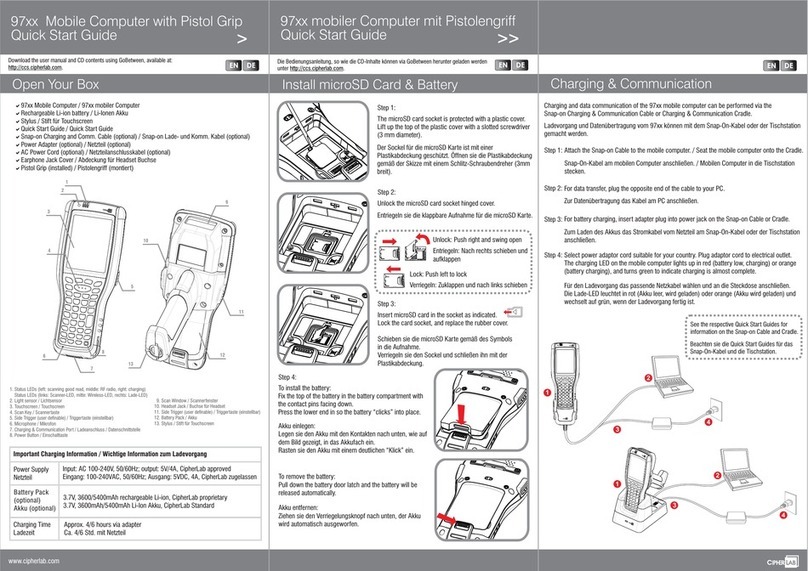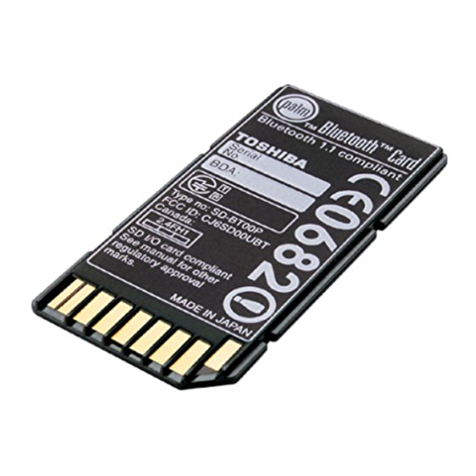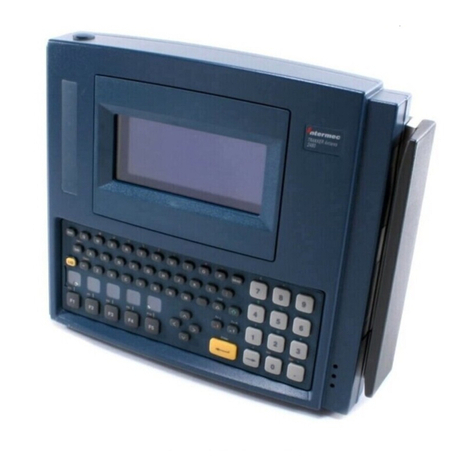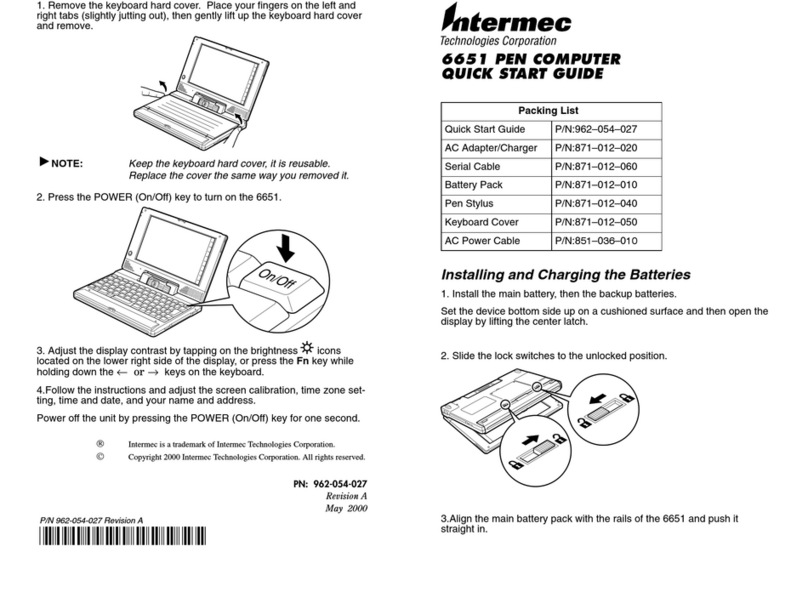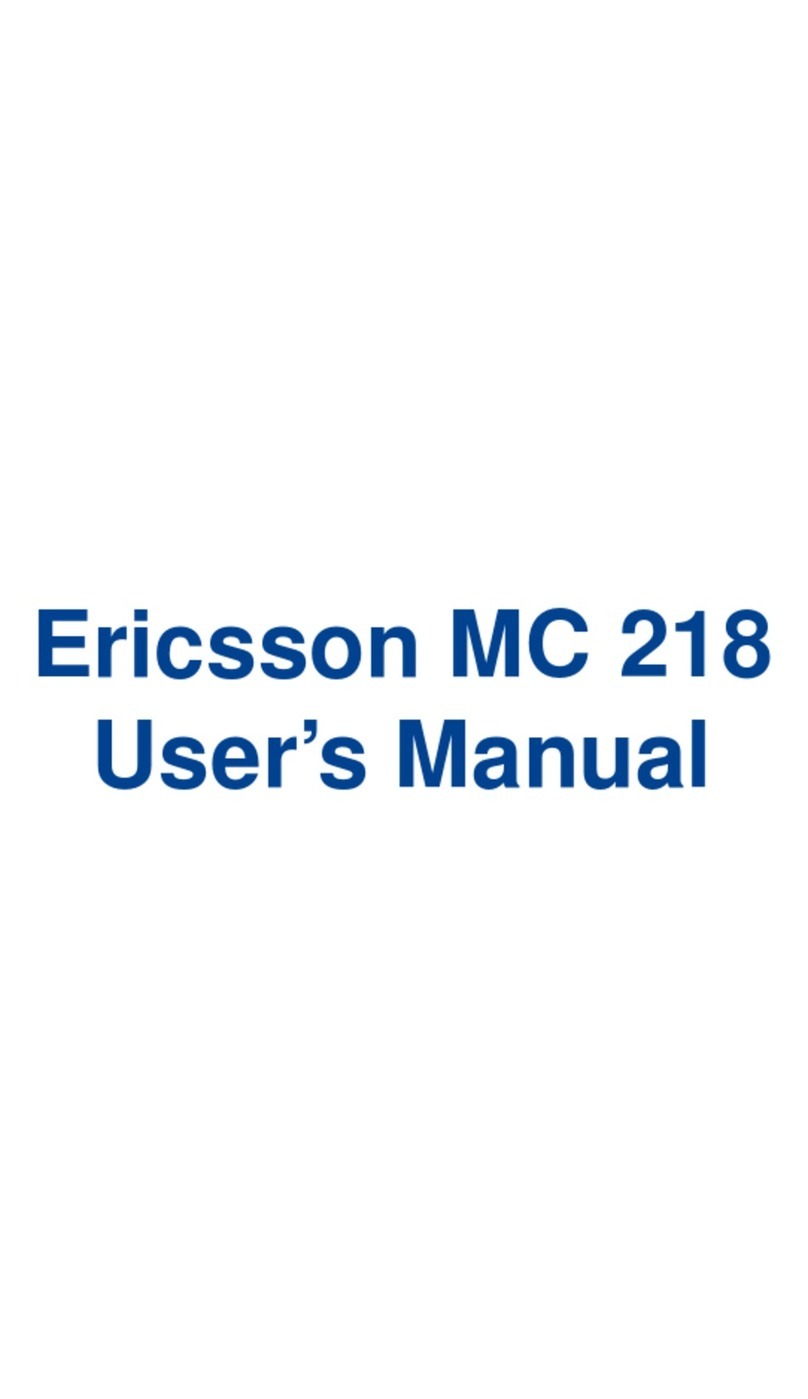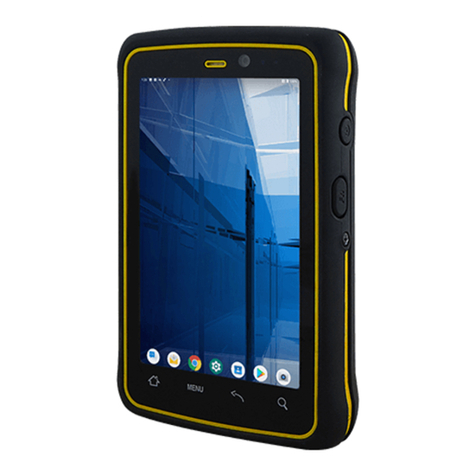gigatrak Intermec CS40 User manual

Intermec CS40 Handheld Information
IntermecCS40HandheldInformation080511.doc Page1
Home Screen – View 1
Home Screen – View 2
Interacting with the Screen:
;.
Touchscreen Calibration
If the touchscreen is not responding properly to stylus touch taps, the touchscreen may need to be
recalibrated.
1) Tap the Start > Settings > System > Screen
2) Follow the instructions on the screen
USE ONLY the STYLUS to complete the alignment.

Intermec CS40 Handheld Information
IntermecCS40HandheldInformation080511.doc Page2
Set Date/Time/Time Zone
1) Tap the Start button in the system tray.
2) Select “Settings”, then “Clock and Alarms”.
3) Set your time zone.
4) Set the current date, time.
5) OK to Exit.
Set Backlight Power
(The unit has an ambient light sensor, and will turn off when there is no activity.
Tap screen or press a key to resume)
1) Tap the Title bar at the top of the Home screen. Horizontal scroll bar appears under the Title bar.
2) Tap the Battery icon. Power screen appears.
3) From the horizontal scroll bar at the top, select Advanced
On Battery Power – Make your choices.. Turn off screen, check or uncheck box, Set Timer
On External Power – Make your choices..Turn off screen, check or uncheck box, Set Timer
. 4) Select OK at the bottom right of the screen to save.
Set Screen Brightness
1) Tap Start > Settings > System > Backlight
2) Adjust the slider to desired brightness
3) Check or uncheck box for “turn off backlight”… Set Timer”
4) Check or uncheck box for “turn on backlight” if button pressed, or screen tapped”
5) Tap OK at bottom right of the screen to save.
Check Power Settings
1) Start | Settings
2) Tap the Power icon – power settings display

Intermec CS40 Handheld Information
IntermecCS40HandheldInformation080511.doc Page3
Turn on ScanWedge
1) The ScanWedge Utility is active by default.
2) If the imager/scanner does not scan, it might be “disabled”.
3) To check the setting: Start > Settings > Systems > Intermec Settings > Data Collection >
Internal Scanner
4) “Enable scanner port” should be “on”…….
5) If not, Tap Enable Scanner Port , and check box to enable scanner.
6) Tap OK at bottom of screen to save setting.
Enable Barcode Symbology for Scanning:
1) While many typical barcode symbologies are enabled by default, others may need to be
enabled for particular applications.
2) To enable or configure barcode symbologies: Start > Settings > Systems > Intermec
Settings > Data Collection > Internal Scanner > Symbologies
3) Check and enable/configure the Symbologies required.
Append Carriage Return to Barcode scan
If the screen cursor does not advance to the next data field in your application after scanning a
barcode, you need to append a carriage return to the barcode scan.
1) From the Home Screen, Start | Settings | System | Intermec Settings | Data Collection |
Internal Scanner | Symbology Options | Post Amble
Intermec Settings Main Menu
2) Enter ”\x0D” for a Carriage Return
3) Tap OK at the bottom of the screen to Save your changes

Intermec CS40 Handheld Information
IntermecCS40HandheldInformation080511.doc Page4
Enable Wireless 802.11 (WiFi) Radio:
1) Tap: Start > Settings > Systems > Intermec Settings > Communications >802.11 Radio
> Radio Enabled
2) Select the Radio Enabled check box and Tap OK.
3) Use Intermec Settings to configure communication parameters (including security) for your
network.
Turn On/Off Bluetooth (opt 1):
1) Tap: Start > Settings > Connections | Wireless Center |
2) Tap Bluetooth to turn on/off the Bluetooth radio
3) Tap OK to close the wireless center
Turn On/Off & Configure Bluetooth (opt 2)
| Note: Reference the Intermec CS40 User’s Guide for specifics to connect to BT
devices.
Turning the Phone On and Off (Enable the phone):
1) From the Home Screen, Start | Settings | Connections | Wireless Center |
2) Tap Phone to turn on the Phone
3) Tap OK to close the wireless center

Intermec CS40 Handheld Information
IntermecCS40HandheldInformation080511.doc Page5
Make a Phone Call:
1) Press Phone from the Home screen (or) Tap the green phone key on the upper left side of
the keypad.
2) Tap the keys to enter the phone number you want to call
3) Tap Talk
Take a Picture:
1) Tap Start > Pictures & Video
2) Tap the Camera icon in the grid (or) the Camera button on the Title bar
3) Press Enter to take and save the picture.
Turn off the Terminal:
Press and hold the Power Button, at the upper right of the keypad (red phone icon on key
OR)
Select Start | Shutdown icon

Intermec CS40 Handheld Information
IntermecCS40HandheldInformation080511.doc Page6
APPENDIX 1 – Embedded Intermec Functions
iSpy WiFi v: Use iSpy WiFi to check 802.11 radio status and diagnose
connection issues.
Scan Diagnostic:
Use ScanDiagnostic application to diagnose problems with scanner.
Wireless Center:
Profile Settings:
Intermec Settings:

Intermec CS40 Handheld Information
IntermecCS40HandheldInformation080511.doc Page7
APPENDIX 2 –
Configure Wireless 802.11 Radio/ Security/Network
Enable Wireless 802.11 (WiFi) Radio:
4) Tap: Start > Settings > System > Intermec Settings > Communications >802.11 Radio >
Radio Enabled
5) Select the Radio Enabled check box and Tap OK.
6) Use Intermec Settings to configure communication parameters (including security) for your
network.
Select Wireless Security Choice for 802.11 (WiFi) Radio:
1) Tap: Start > Settings > System > Intermec Settings > Communications >802.11 Radio >
Security Choice
2) Select the Funk Security check box and Tap OK.
3) Use Intermec Settings to configure communication parameters (including security) for your
network.
Setup Wireless Security Choice for 802.11 (WiFi) Radio (If USING Static WEP):
1) Tap: Start > Settings > System > Intermec Settings > Communications >802.11 Radio >
Funk Security
2) Select the Profile 1. (or 2, 3 or 4 if adding additional Profiles)
3) Enter Profile Label (name)
4) Check radio Box for Network type:
a. Infrastructure for Access Points (this is the typical choice)
b Ad Hoc for PC to PC, or Device to Device, or Device to PC
5) Enter SSID (unique wireless network name)
6) Check radio Box for Power Mode: check CAM (for constant awake mode)
7) Select 802.1x security type (if used): none
8) Select Association: Open
9) Set Encryption: WEP
Define a value for the keys you want to use. You can define up to
four keys (Key 1 through Key 4).
Enter an ASCII key or a hex key that is either 5 bytes or 13 bytes long depending
on the capability of the radio. Set a 5- byte value for 64-bit WEP or a 13-byte value
for 128-bit WEP. Hex keys must be preceded by 0x and contain 5 or 13 hex pairs.
For Transmit key, if used, choose the key you want to use for transmitting
your data
10) The rest of the screen requires scrolling through to set any necessary security options.
If you don’t know what these are – contact the IT staff.
11) To Save your settings, Select OK at the bottom menu panel if no additional changes are
needed.

Intermec CS40 Handheld Information
IntermecCS40HandheldInformation080511.doc Page8
Setup Wireless Security Choice for 802.11 (WiFi) Radio (If USING Personal WPA/WPA2):
1) Tap: Start > Settings > System > Intermec Settings > Communications >802.11 Radio >
Funk Security
2) Select the Profile 1. (or 2, 3 or 4 if adding additional Profiles)
3) Enter Profile Label (name)
4) Check radio Box for Network type:
a. Infrastructure for Access Points (this is the typical choice)
b Ad Hoc for PC to PC, or Device to Device, or Device to PC
5) Enter SSID (unique wireless network name)
6) Check radio Box for Power Mode: check CAM (for constant awake mode)
7) Select 802.1x security type (if used): none
8) Select Association: WPA or WPA2
9) Set your PSK (aka, Pre-shared key)
The pre-shared key must be a value of 32 hex pairs preceded by 0x
for a total of 66 characters. The value must match the key value on
the access point. The passphrase must be from 8 to 63 characters.
After you enter a passphrase, the 70 Series internally converts it to
a pre-shared key. This value must match the passphrase on the
authenticator.
10) The rest of the screen requires scrolling through to set any necessary security options.
If you don’t know what these are – contact the IT staff.
11) To Save your settings, Select OK at the bottom menu panel if no additional changes are
needed.
Setup Wireless Security Choice for 802.11 (WiFi) Radio (USING Any OTHER Security
Option)……
Reference the supplement document located on the GigaTrak website:
Personal WPA/WPA2): IntermecCK_CN_SC Series WirelessConfigSupplement
Select Active Profile for Wireless Security for 802.11 WiFi) Radio:
1) Tap: Start > Settings > System > Intermec Settings > Communications >802.11 Radio >
Funk Security
2) Select Active Profile
3) Check desired Profile (1, 2, 3 or 4)
4) Enter Profile Label (name)
5) Select OK at the bottom menu panel.

Intermec CS40 Handheld Information
IntermecCS40HandheldInformation080511.doc Page9
Setup IP Configuration for 802.11 (WiFi) Radio network communications:
1) Tap: Start > Settings > System > Intermec Settings > Communications >802.11 Radio >
IP Settingds
2) Select DHCP Check box if DHCP (dynamic host connect protocol) is used and IP address
will automatically be assigned by a server.
3) Enter DHCP client ID (name) if applicable
4) OR
5) Uncheck DHCP if IP is static and will be assigned based on specific IP address given.
6) If Static IP, then enter required additional network information:
a. IP Address
b. Subnet Mask
c. Default Router
d. Primary DNS (if applicable)
e. Secondary DNS (if applicable)
f. Primary WINS (if applicable)
g. Secondary WINS (if applicable)
h. Enter SSID (unique wireless network name)
7) Select OK at the bottom menu panel if no additional changes are needed.

Intermec CS40 Handheld Information
IntermecCS40HandheldInformation080511.doc Page10
APPENDIX 3 – GigaTrak Application Installation Notes
Microsoft Active Sync Installation (For Windows XP)
1) Locate a copy of the latest version of Active Sync for your computer system. The correct version
is available from Microsoft’s WEB site or a copy is included on your CD. Version 4.5 is the latest
from Microsoft as of this printing.
2) Look for the installation file (i.e. activesync_setup.msi) and run it. We recommend that you follow
the installation instructions and accept the standard default settings during your install.
3) Leave Active Sync running to install and connect your handheld computer.
NOTE: Some users may use a single PC to connect multiple handheld computers. If this is the case,
it is best to setup your PC to recognize each handheld as a “Guest”. This avoids having Active Sync
loading shared data from your Outlook and other PC applications. To set all connected handhelds as
a Guest, please double-click and run the provided “GuestOnly.reg” file. It will instantly update your
system for future connections.
Windows Mobile Device Center Installation (For Windows Vista or Windows 7)
1) Locate a copy of the latest version of Windows Mobile Device Center for your computer system.
The correct version is available from Microsoft’s WEB site or a copy is included on your CD.
2) Look for the installation file (i.e. drvupdate-x86.exe) and run it. We recommend that you follow
the installation instructions and accept the standard default settings during your install.
Install GigaTrak Handheld Application – WIRELESS and/or Batch versions
The handheld application files can be found in the PocketPC folder of your installation CD (or was
provided to you via email).
1) Connect the handheld docking station to your computer (typically a USB connection) and plug in
the AC power cable.
2) Put the handheld in the dock and wait for it to sync with the PC.
3) Copy the CAB file to the device using ActiveSync (XP) or Windows Mobile Device Center
(Vista/7). -- Any folder, it doesn't matter where.
4) Once the file(s) is(are) copied, disconnect the USB cable.
5) On the handheld itself, browse to the folder where you installed the *.CAB file and click on the
CAB file to install.
a. WIN_xxx-W.cab (for the Wireless Application
b. WIN_xxx.cab (for the Batch Application)
6) If prompted, select Device as the install location. On the handheld, click the file to run it – this
will install the application on the handheld.
7) Exit out to the main desktop screen on the handheld.
8) Start | Programs | xxx_xxx-W to run the Wireless version of the application
9) Start | Programs | xxx_xxx to run the Batch version of the application

Intermec CS40 Handheld Information
IntermecCS40HandheldInformation080511.doc Page11
NOTE: From the PC Application, when selecting to Synchronize with a Batch terminal, set the
following designation: Select Download Icon > Select Handheld Button > Select (Other)
Files from the PC database will then download to/upload from the Program Files\xxx (batch)\
directory on the handheld.

Intermec CS40 Handheld Information
IntermecCS40HandheldInformation080511.doc Page12
APPENDIX 4 – Intermec Support Manuals
Additional CS40 Manuals online @ Intermec:
http://www.intermec.com |Support | Manuals |
Product Category- computers
Product Family – Handheld Computers
Product – CS40
http://www.intermec.com/support/manuals/search.aspx?categoryid=3&familyid=8&productnodeid=CM
PTRCS40

Intermec CS40 Handheld Information
IntermecCS40HandheldInformation080511.doc Page13
APPENDIX 5 - Reboot, Warm Boot, Cold Boot, Reset Terminal
Re-Boot Terminal:
Rarely does the CN3 require resetting, but it if does not respond properly, it reset may be
necessary. Perform a warm boot first and see if that fixes the problem. If it does not, then
perform a cold boot.
Warm Boot the Handheld (Preferred Reset Method)
Press the Start | Programs | Shut Down (OR) Scan the barcode below (must be high
quality barcode print out):
The unit screen will systematically shut down, restart and go through the initialization
process.
Press the Power button to restart.
Cold Boot the Handheld (Secondary Reset Method)
Cold booting is only recommended if the computer completely stops responding.
Cold booting the terminal may result in data loss. Configuration and network settings will be
preserved.
To Cold Boot, tap Start > Programs > Shut Down.
Remove the battery pack, and wait at least 30 seconds..
Reinstall the battery pack.
Press Power and wait while the terminal boots:
When Cold Boot is complete, the Home screen will appear.
Set the date and time after each cold boot to ensure that the system clock is accurate.
Clean Boot the Handheld (Totally erases all memory in the terminal, including applications
loaded by user. Will load only default files and original programs upon restart.)
Clean booting is only recommended if the computer completely stops responding.
To Cold Boot, tap Start > Programs > Shut Down.
Remove the battery pack, and wait at least 30 seconds..
Reinstall the battery pack and press the Power button.

Intermec CS40 Handheld Information
IntermecCS40HandheldInformation080511.doc Page14
Select 2from the IPL Menu to Select Force Clean Boot
Then, Press 0to Select Continue with Boot.
The computer will clean boot……this process will take a few minutes..
When prompted, tap the screen to set up the computer.
Follow instructions to align computer and reset any system settings previously made.
Set the date and time after each cold boot to ensure that the system clock is accurate.

Intermec CS40 Handheld Information
IntermecCS40HandheldInformation080511.doc Page15
APPENDIX 6 – CS40 Terminal Keypad and Overview
Battery Status LED:

Intermec CS40 Handheld Information
IntermecCS40HandheldInformation080511.doc Page16

Intermec CS40 Handheld Information
IntermecCS40HandheldInformation080511.doc Page17
APPENDIX 7 – CS40 Micro SD Card Installation Overview:
Remove the battery, and open the compartment below it:
MicroSD card slides into bottom slot to the left
SIM card inserts into compartment door on the top right
Other gigatrak PDA manuals

